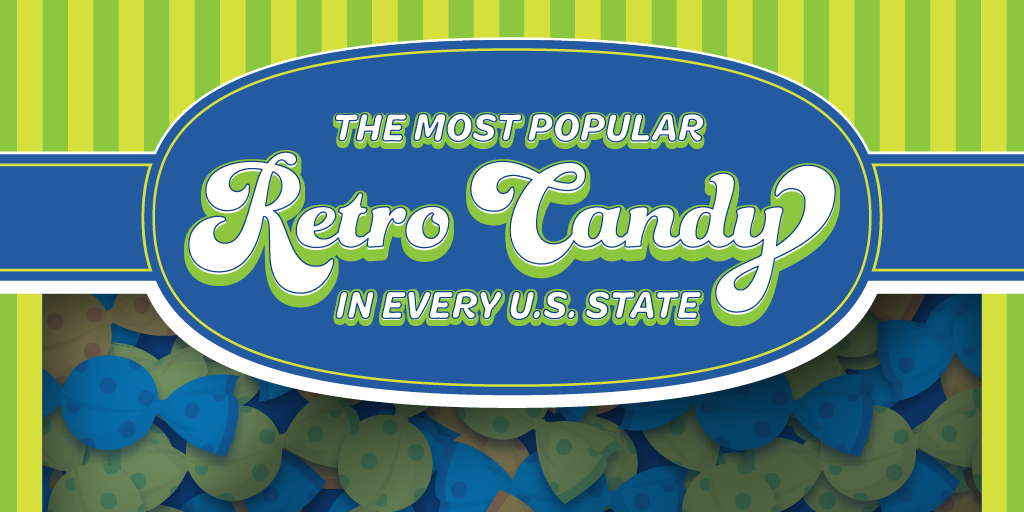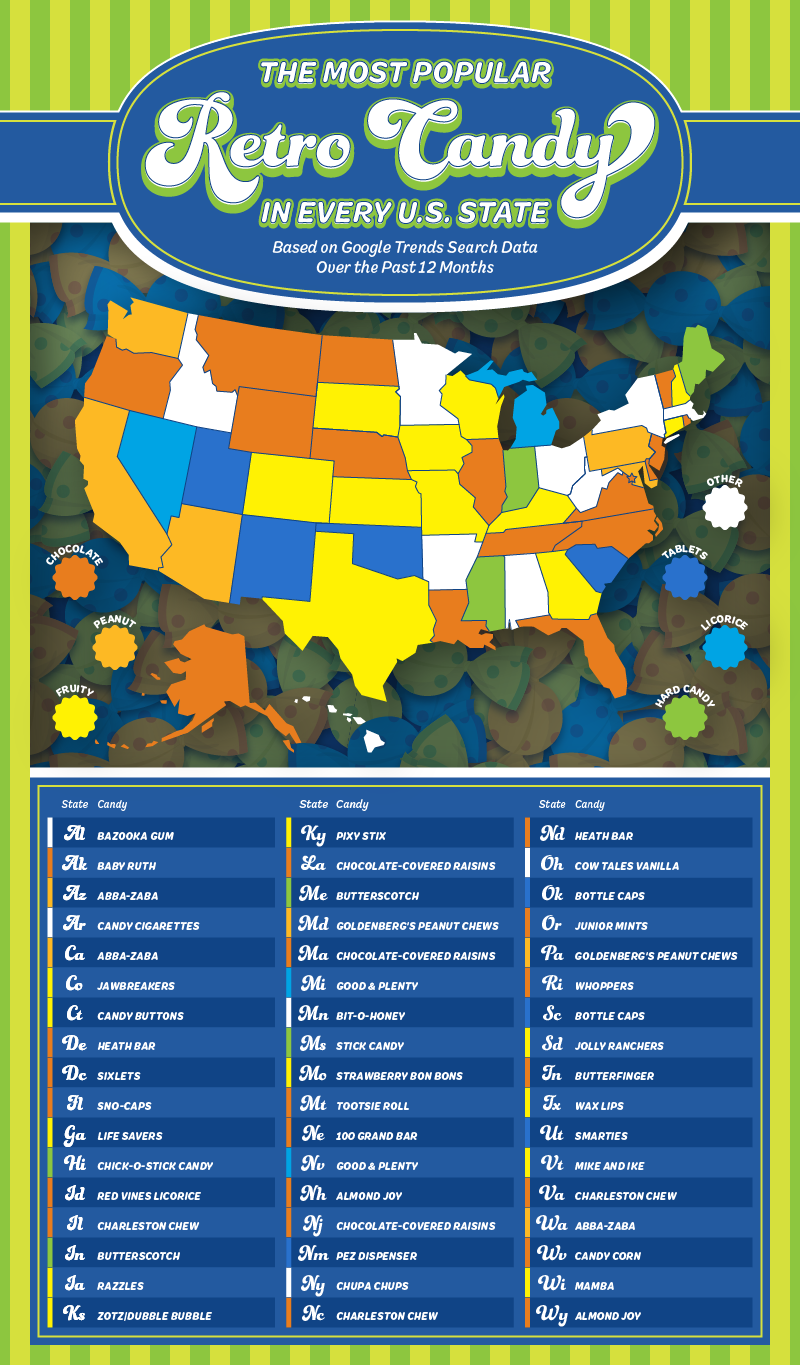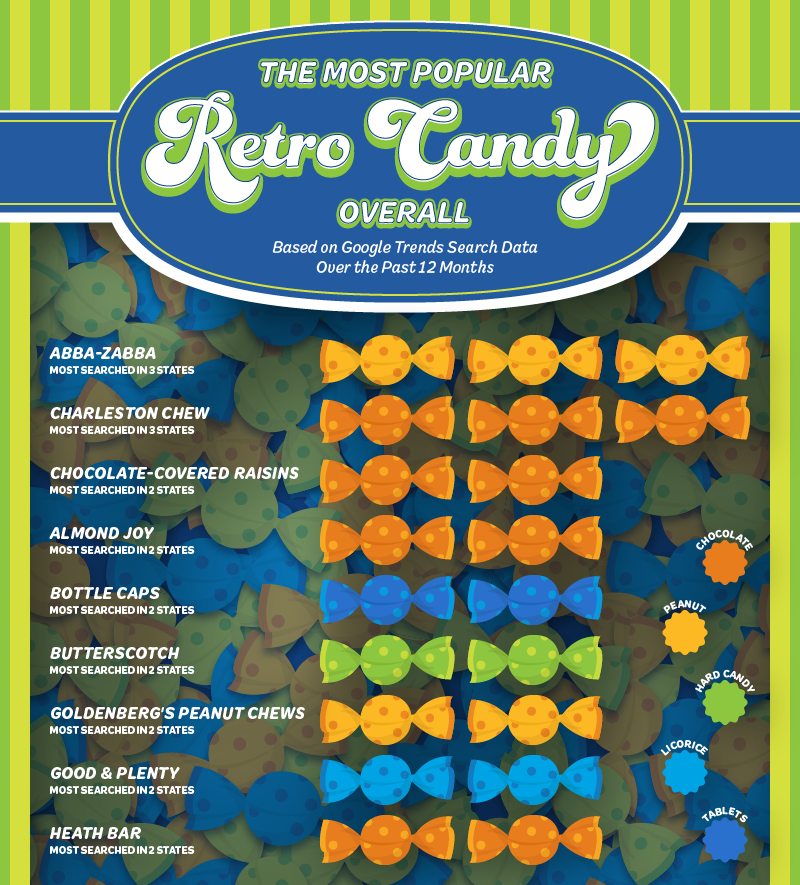
Feeling nostalgic? Let’s take a sweet down memory lane. When was the last time you walked into a store and spotted Bazooka Gum or anticipated getting to the checkout lane at the grocery store? Although eating piles of candy continues to be a staple of everyone’s childhood, the kind of candy changed over the years.
Today’s candy aisles are filled with big brand names like Snickers or Reese’s, but can you even find these timeless classics anywhere? From the infamous strawberry candies in everyone’s grandma’s glass dish to old-school candy bars, each retro piece of candy is a blast from the past. Most Americans have a go-to candy bar that brings them the ultimate comfort, but not everyone has the same taste. What’s your state’s favorite throwback sweet?
Methodology
Trying to find Americans’ favorite candy in every state was jawbreakingly sweet, but no easy task. Based on a list of 58 childhood candies that are still being produced today, we used Google Trends data from February 2021 to February 2022 to find out which nostalgic candy is America’s favorite.
The Most Popular Retro Candy in Every U.S. State

Get ready to feel like a kid in a candy store because the mouthwatering results are in! One reason we love retro candy is for the huge range of different flavors or wacky combinations they offer. Whether your favorite flavor is tongue-tinglingly sour, tangy, or sugary, the feelings they bring are still stuck in our minds.
Does your old-school sweet tooth have the same cravings as your state? Abba-Zabba and Charleston Chews are the most popular, appearing as the favorite retro candy of 3 states. Chocolate-covered raisins, Almond Joys, Bottle Caps, Butterscotch, Goldenberg’s Peanut Chews, Good & Plenty, and Heath Bars also got some love as each is the favorite retro candy in 2 states.
The Most Popular Retro Candies Overall

The Abba-Zabba candy bar is happiness in the form of white taffy with a creamy peanut butter center. The chewy taffy has been America’s favorite for nearly a century, but the unlikely combination is most loved in Arizona, California, and Washington. First manufactured in 1922, the peanut butter goodness is made by Annabelles candy in California. In one bite, your tastebuds will be transported to an old-fashioned local candy store.
Named after a popular early 20th-century dance, the chewy, flavored nougat wrapped in a rich, chocolate coating has made the Charleston Chew a favorite candy since 1925— especially in Illinois, North Carolina, and Virginia. Created by the Fox-Cross Candy Company, the bar is available in three flavors: strawberry, chocolate, and vanilla.
Louisiana, Massachusetts, and New Jersey like the best of both worlds with the chocolate-covered raisins being their favorite candy. First introduced in 1926, chocolate-covered raisins sweet bites are so irresistible you’ll find yourself repeatedly reaching for handfuls more.
“Sometimes you feel like a nut”, sometimes you don’t. Love them or hate them, despite any hate the Almond Joy may receive for the coconut taste, the retro candy has managed to climb up to be one of the most popular candies in America—a favorite in New Hampshire and Wyoming.
Which bottle cap candy flavor was your favorite: Root beer, grape, cola, cherry, or orange? Making their first debut in the 70s, each refreshingly sweet cap captures the flavors of your favorite soda. Oklahoma and South Carolina love them all. The tablet-sized candy first hit the shelf in 1972.
Butterscotch takes on many forms, but one of the most popular ways is as a hard candy—and it’s not hard to see why. Indiana and Maine love to curve their sweet tooth with these old-fashioned candies. Created in a town in Yorkshire, England in 1817, there’s no clear origin of the name. Although the “butter” part remains obvious, “scotch” is a mystery.
Fun fact: Goldenberg’s Peanut Chews were first used in the U.S. military during World War I as a ration bar. The high protein recipe and unique flavor made the retro candy popular among the troops. It wasn’t until four years after its making that the chews were introduced to stores. Maryland and Pennsylvania have adored the nostalgic candy since.
Believed to be the oldest candy brand in America, Good & Plenty is the definition of old-fashioned. Black licorice isn’t for everyone, but Michigan and Nevada beg to differ. Even if you’re not a huge fan, you could spot the box from a mile away. The pink-and-white chewy pieces were first produced in 1893 in Philadelphia. The retro candy can still be found in the candy aisles or concessions everywhere.
Deliciously crunchy English toffee on the inside and smooth milk chocolate draped on the outside are on the minds of Delaware and North Dakota. These scrumptious bars have been around since the 1920s, and it’s no surprise the savory combination of the Heath Bar has become one of America’s favorites.
Closing Thoughts
They don’t make candy like they used to, do they? From the bright colors to the wide assortments of sweets, there will always be something magical and whimsical about trips to the local candy store. Even after years and years, our childhood favorites continue to be sold today. And while you never really outgrow your love for nostalgic candy, you or someone you love may have outgrown the usefulness of a life insurance policy. If you’re looking to find out how much your life insurance policy is worth, contact us at Coventry Direct to see if you qualify to sell your policy today!

